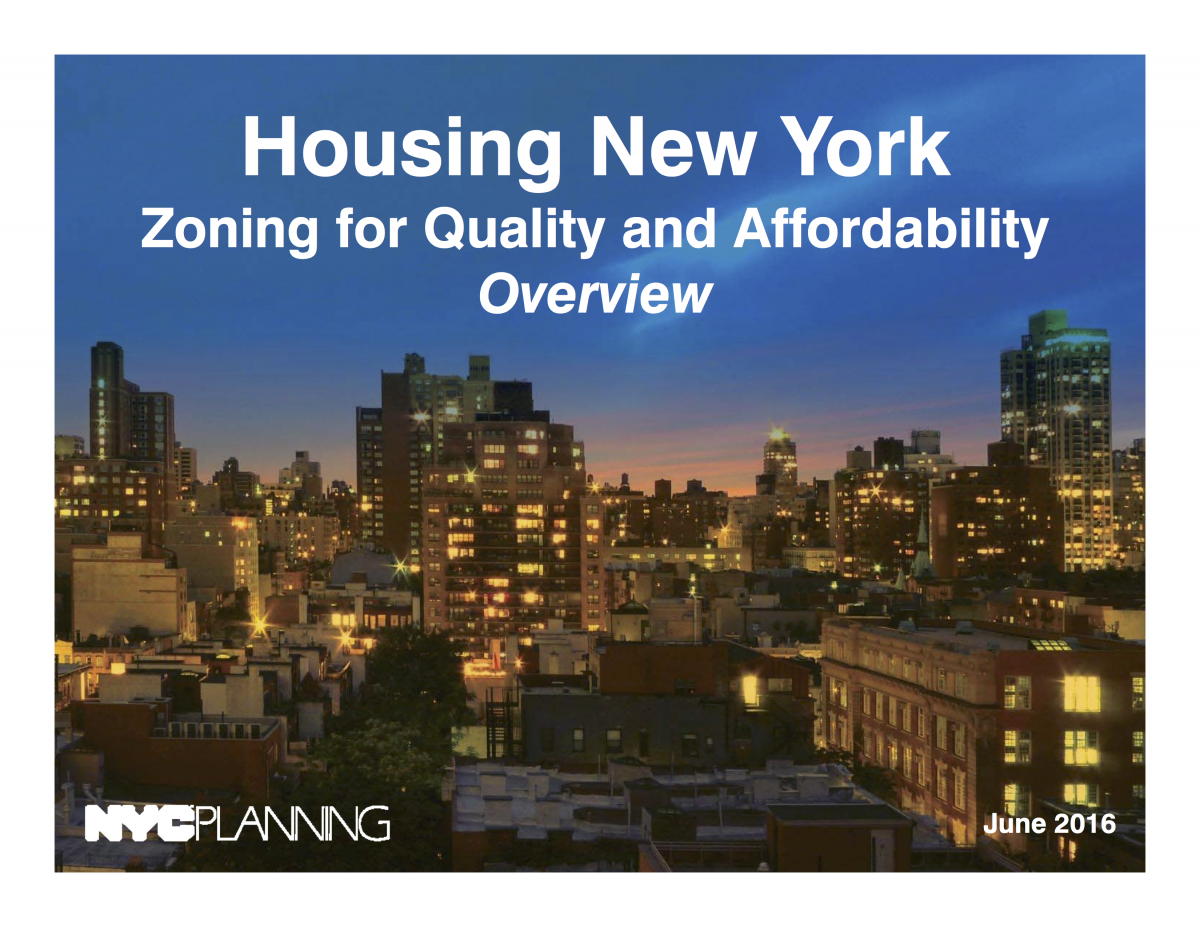Last month we provided a summary of the new zoning text changes in Mayor De Blasio's Mandatory Inclusionary Housing Program. This month, we take a closer look at the zoning changes in NYC's other housing program, Zoning for Quality and Affordability (ZQA).
OVERVIEW OF ZONING FOR QUALITY AND AFFORDABILITY
Along with the new Mandatory Inclusionary Housing regulations, the Department of City Planning also made changes to the Zoning Resolutionin order to address unintended consequences of the city’s previous zoning. Specifically, these zoning text changes—called Zoning for Quality and Affordability (ZQA)—aim to encourage quality, affordable residences. In terms of affordability, the new text encourages affordable senior housing and care facilities, quality Inclusionary Housing, and the reduction of parking requirements for transit-accessible affordable housing. In terms of quality, the new text encourages ground-floor retail, higher ceilings in residential units, and the accommodation of façade articulation, courtyards, and other aesthetically pleasing elements. Specifics on these changes are described below.
OVERVIEW OF ZQA ZONING TEXT CHANGES
Parking Regulations
With these regulations, no parking is required for affordable senior housing or income restricted housing within transit zones. The assumption is that most people in these areas are using public transit rather than driving cars. Parking requirements were decreased for senior housing since seniors are typically too old to drive and thus don’t require as much parking. Parking requirements were decreased for affordable housing to make it easier to provide more affordable housing, since not all lots are large enough to accommodate additional housing and parking associated with this housing. Additionally, any development on an existing, previously required affordable senior housing parking lot within a transit zone may not include market rate housing.
Affordable Independent Residences for Seniors
Baby boomers are aging, and in the not-so-distant future, there is going to be a large need for senior housing. New bulk regulations for affordable senior housing were created to incentivize the creation of this type of housing and meet this future demand.
Extra floor area is available for affordable independent residences for seniors as well, and additional height is permitted for affordable independent residences for seniors in many zoning districts; this even applies to some contextual districts, which now have permitted building heights that are 5’-30’ higher than previous permitted heights. Additionally, increased dwelling unit sizes are required within these affordable independent residences for seniors.
Quality Housing Regulations
Currently, some developers create buildings with low ceilings as a way to fit additional floors in areas that have height limits. To allow for more livable residential spaces—and to encourage higher ground floors that can sufficiently accommodate retail—height limits have been relaxed. There are also new regulations that encourage more aesthetically pleasing streetscapes and building designs. Specifics on these changes are listed below:
Height Regulations
In numerous contextual districts, an additional 5’ in height is permitted for quality housing buildings with first floors that are at least 13’ tall; however, there are limits for buildings abutting lower-density residential districts.
There are new restrictions on the number of stories permitted in quality housing buildings now, as well, as a way of preventing developers from using short ceiling heights in order to fit more stories in their permitted building envelopes.
Other Bulk Regulations
There are more stringent street wall regulations for quality housing buildings, with provisions that allow for articulation and more interesting building designs. Also, farther initial setbacks are encouraged in order to accommodate wider sidewalks.
Streetscape Regulations
There are new ground floor regulations intended to improve streetscape conditions for quality housing buildings. Additionally, there are new signage regulations for non-quality housing buildings.
Lot Coverage/ Yard Regulations
Quality housing buildings on corner lots are now permitted to have 100% residential lot coverage in any zoning district. Rear yard equivalent regulations for quality housing buildings have been adjusted for R6-R10 districts.
More information on the MIH and ZQA programs can be found on the City Council's website. For any additional questions or comments on this topic, please contact Milrose Consultants.
To stay informed on the latest zoning changes impacting the real estate development industry, subscribe to our free monthly newsletter.








